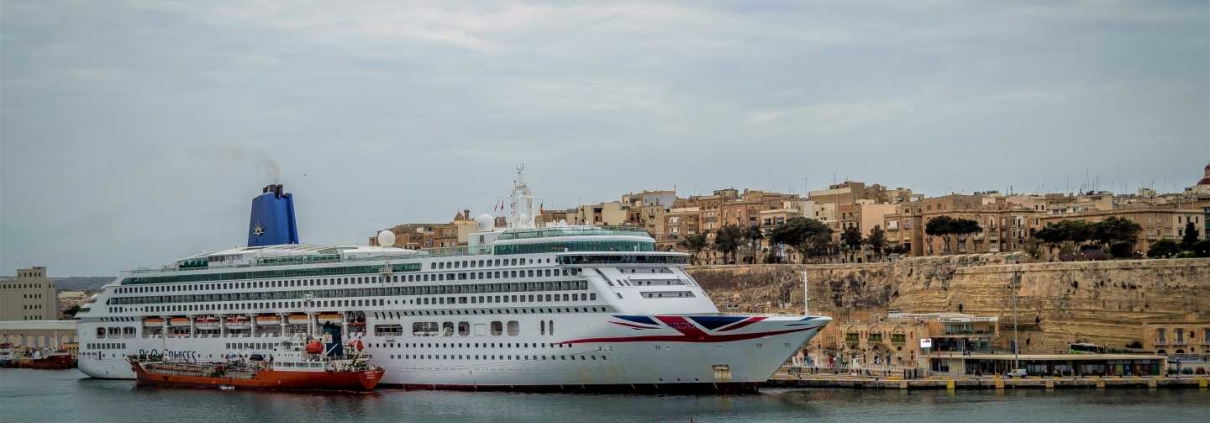Celebrating 180 years of the P&O – Malta Connection
On 14th January, Malta and the Grand Harbour were honoured to be the first port to host Aurora in her circumnavigation of the globe. Apart from Aurora, P&O Oceana will be homeporting out of Grand Harbour throughout 2017. This will be a P&O first for Malta. Both events will crown the 180-year old connection between the company and Malta.

In 2017 Aurora follows in the wake of several famous P&O liners, as will her passengers, who will share the epic voyages of Empire builders, administrators, soldiers, sailors, settlers, explorers, botanists, scientists, the girls of the ‘fishing fleet’, who came out in search of prospective husbands, and illustrious personalities from William Makepeace Thackeray to Florence Nightingale, Giuseppe Garibaldi and Rudyard Kipling.
The roots of P&O date back to 1837, when the Peninsular Steam Navigation Company, as it was originally known, inaugurated a mail and passenger service between London, Falmouth, Iberian Peninsula, and Gibraltar. Her Majesty’s packets took over from Gibraltar to Malta, Corfu and Alexandria.
P&O originally traded to Spain and Portugal; this explains the ‘Peninsular’ in the official name. Its assistance to the Spanish and Portuguese Crowns during the civil wars of the 1830s earned it the right to fly the countries’ national colours on its pennant: red and gold (P&O used yellow) of the Spanish Bourbons, and blue and white of the Portuguese House of Braganza. These colours were subsequently quartered on the house flag, which is one of the oldest still in use, and worn Blue to the mast, Red to the fly, Yellow to the deck, White on high. P&O took its motto Quis Nos Separabit, meaning ‘who shall separate us’, from its determination to serve the far corners of the earth, despite the, as yet, canal-less Isthmus of Suez and the dearth of facilities for steamships. After 180 unbroken years, the motto could well apply to its connection with Malta.

By the 1850’s the mail service had been extended to Singapore, China and Sydney. Passengers and mail journeyed from London by train for Marseilles, where they boarded the ships for Malta and beyond. After the opening of the Mont Cenis railway tunnel the company also diverted mails to Brindisi direct for Alexandria.
Florence Nightingale, the ‘Lady with the lamp’, called aboard Vectis after a voyage from Marseilles to Scutari to set up nursing facilities during the Crimean War. She was seasick throughout the voyage and did not come ashore at Malta though her nurses were feted by officers from the army. Giuseppe Garibaldi also arrived aboard the Vectis on his way to England; he sailed for Southampton on Ripon, arriving on April 3, 1864.
In 1844, P&O offered William Makepeace Thackeray (1811-1863) a free voyage to the Mediterranean. It was advertised as a Grand Tour; with this voyage P&O is traditionally taken to have invented cruising, albeit not in the modern sense of the word. Thackeray sailed on three different P&O ships employed on scheduled liner service carrying mails, passengers and cargo. He also recorded the earliest preserved P&O menu. In his time Thackeray was ranked second to Charles Dickens as a writer, but is now best remembered for his social satire Vanity Fair.
Thackeray arrived in Malta on September 5, 1844 by way of Lisbon and Gibraltar on P&O Lady Mary Wood. His description of Grand Harbour and Valletta are typical of most visitors’ observations: busy, bustling, noisy, quaint, the London shops a reminder of home, and the squads of priests, habited after the fashion of Don Basilio in the opera. He toured the sights and was made honorary member of the Union Club in Strada Reale, then called Queensway, now Republic Street.
Malta and its harbours have a special place in the 180-year-old history of the company. In The Story of Malta (1893) the American publisher and travel writer Maturin Murray Ballou described Malta as ‘the half-way station, as it were, of the P&O Line between London and Bombay’. As to the benefits, ‘it is computed that the passage by each P&O steamer that stopped at the port on its way East or West, leave an average of 500 to 600 dollars distributed among the fancy goods merchants, and we should say this is a very moderated estimate’.
‘The arrival of a P&O steamship in the harbour of Malta with a goodly number of passengers bound either east or west, is a harvest time for the beggars, who know very well how to challenge the generosity of strangers. They have made a careful study of the business: they have elevated it, as De Quincey says, to the status of a fine art. The Nix Mangiari Steps of Valletta are the congregating place of an army of mendicants of every species, men, women, and children, who exhibit all manner of deformities, both real and artificial, as well as every grade of dirt and squalor. In landing and making one’s way up to the main thoroughfare of the city, it is necessary to run the gauntlet of this poverty-stricken people’.
Marsamxett Harbour was for several years partly the exclusive domain of the company and was popularly referred to as the P&O Harbour. P&O set up facilities at Marsamxett soon after incorporation by Royal Charter. At Malta, as at many other ports thereafter, the company started from scratch, building coal and goods stores as well as a customs verandah for passengers. Part of the harbour could have been given over to the company (as far as is known this arrangement applied solely to P&O) to facilitate quarantine at the adjacent Lazzaretto. Inside this huge complex of buildings, passengers and merchandise were screened against insidious shipborne diseases such as the plague and cholera. P&O ran services to the Levant and the Orient; the dangers of infection from countries in these regions were never underestimated.

P&O activities at Marsamxett made that harbour extremely busy, the turnaround surpassing that of the Lazzaretto. The McCarthy Report (1908) on the Customs Department considered that that the maintenance of permanent staff for P&O and the Lazzaretto was wasteful, considering the intermittent nature of the work. When the ships were in, Customs guards were in attendance at the P&O sheds, one of which was for cargo and passenger baggage subject to duty. The men also attended the verandah where passengers were landed, which incidentally, is the only extant reminder of the company’s activities in Malta.
Some days were busier than others. On September 12, 1910, there were three P&O ships in harbour – Sicilia, Namur and Vectis. Sicilia also served as a troopship. When she sailed out of Marsamxett earlier in 1906, it was not goodbye but au revoir for five men from the Rifle Brigade who had got engaged to Maltese girls. Vectis was in harbour for 14 hours with 200 cruise passengers.
Marsamxett came alive when P&O ships called. The ships were surrounded by dgħajsas, the local passenger boats, water barges, coal lighters, bumboats and boys who dove for coins thrown by passengers who remained aboard. In 1890, P&O commissioned the artist W.W. Lloyd to draw scenes of the company’s activities. These were published as P&O pencillings. The Malta drawing portrays events surrounding the ship at Marsamxett: Valletta in the background; a Maltese dgħajsa – Me Very Poor Man; boys diving for coins and the service launch Notabile. These pencillings can be seen in an exclusive exhibition at the Malta Maritime Museum in Vittoriosa.

Lloyd sheds light on the hustle and bustle of the luxury cruise voyages; ‘there are boats filled with the most luscious fruits, blood-red oranges, and excellent prickly pears, while it is worth the expenditure of the shilling-worth of coppers to witness the diving feats of the Maltese youths, who will fetch a penny from the bottom of the muddy harbour with far greater speed and ease then our old friend at the Polytechnic used to bring sixpence from his tank.”
P&O continued to provide liner services during World War I. German submarines operating in the Mediterranean took their toll, the ships being targeted on outward and homeward voyages to the Orient and Australia, often after the usual Malta call.
After World War I, the Admiralty took over most of Marsamxett Harbour and P&O joined other shipping in the Grand Harbour, to be berthed by the Mediterranean mooring method that is anchored with stern ropes to bollards at Barriera Wharf, Valletta.
P&O had a couple of ships names dedicated to Malta. Throughout these years there have been two ships called Malta and two called Valetta. There was also a Medina, Melita and Notabile which is the mediaeval name for the ancient capital Mdina. The first Malta was an iron paddle steamer built in 1848. The second was built in 1895. The first Valetta, a wooden paddle steamer built in 1853, was employed on the Marseilles-Alexandria service. The second Valetta of 1883 had the distinction of being the first P&O ship to be fitted with electric light.
Over the years, P&O also carried several thousand Maltese ‘exiles’ – emigrants to Australia, many of whom travelled on assisted passages. For most of them the ships offered a first taste of a different way of life where English was necessary for communication.
After World War II a young emigrant sent home a postcard. He described the public rooms, and exhorted his schoolmates back in Malta to learn English, the language used aboard. Until the advent of air travel P&O also offered the Maltese a gateway to London. The company’s agency advertised cheap fares from Malta to the capital, depending on the availability of cabins on homeward or outward voyages.
In 1995 P&O took delivery of another Oriana, its first new passenger liner since Canberra and Oriana. A sister, Aurora, followed in 2000. The 2017 fleet comprises Oriana, Aurora, Arcadia, Oceana, Ventura, Azura and Britannia, which has the distinction of being the largest cruise ship ever built for the British market.
Until World War II the P&O Malta office was at 41, Merchants Street, Valletta. This was close to the post and telegraph offices and several hotels. After the war, Thos C. Smith took over the agency. In 2015, Mifsud Brothers Ltd, agents for Cunard Line since the 1940s, were appointed agents for P&O Cruises as a result of consolidation within Carnival (UK) Group.

It is truly great to reach this prestigious historical milestone. All P&O cruise ships are very well looked after and the passenger facilities are of the highest standards – a credit to their cruise executives and hardworking crew. I was pleased to see Aurora on our horizons again and watch it sail into our splendid Grand Harbour. We look forward to continue serving P&O with a major turnaround operation this summer. The popularity of such itinerary in the Mediterranean proves that there is a market for such Malta to Malta cruises. I would like to thank P&O cruise executives for their loyalty and for entrusting us. In addition I would like to thank Michael Cassar for his brilliant research on Malta and P&O connection ties. I express my gratitude further to the Malta Maritime Museum for kindly displaying an exclusive P&O exhibition for a themed P&O heritage tour.
Here is to another 180 years of heritage ties with P&O.



